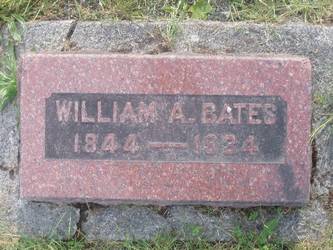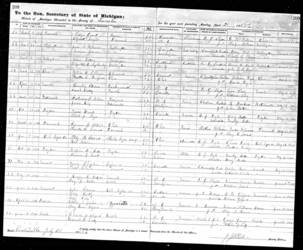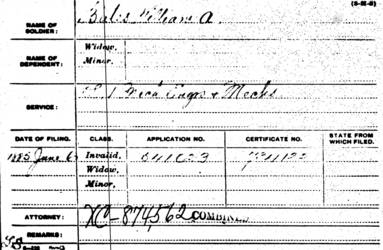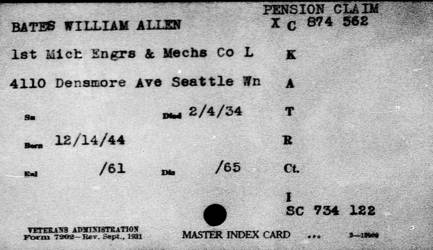William Allen Bates
Representing: Union
Unit History
- 1st Michigan Engineers & Mechanics L
Full Unit History
1st MICHIGAN VOLUNTEER ENGINEERS AND MECHANICS
Organized: 1861 Marshall, MI
Mustered In: 10/29/61 Marshall, MI
Mustered Out: 9/22/65 Nashville, TN
Discharged: 10/1/65 Jackson, MI
Regimental History
REGIMENTAL HISTORY:
The 1st, besides having an interesting name, also had unusual beginnings. In an effort to save to the credit of Michigan several companies being recruited to serve with an Illinois regiment a telegram was sent to the War Department in Washington City which read as follows: "Will the War Department accept a regiment from Michigan on same terms as Colonel Wilson's of Chicago?" The next day the following answer was received: "Yes, with the approval of the governor of the state." Upon receiving Michigan Governor Blair's nod a regiment of ten companies was created. It was equipped as infantry, but - as the Sea Bees of WWII - also provided with implements for engineer service. Pay - wise, it would receive the same extra salary and allowances as engineers in the regular army. This organization was dubbed "First Michigan Engineers And Mechanics."
The regiment left the state on 12/17/61 and proceeded to Louisville, KY. There it was divided into four detachments which were placed throughout the state. These detachments remained with their various assignments throughout the winter of 1861/'62. One was in the 1/19/62 battle of Mill Springs, KY.
In March, 1862 the 1st was concentrated and focused on building railroad bridges in various locations within Tennessee. Then, beginning on 4/3/62 five companies assisted Union Gen. Buell's forces in reaching Shiloh/Pittsburg Landing, TN where, on 4/7/621 they turned a Union defeat (4/6) into a victory.
From Shiloh/Pittsburg Landing the 1st moved to Corinth, MS then on to Decatur, AL building bridges at various points along the Memphis & Charleston Railroad. In July the whole regiment was at Nashville, TN. After that a portion of the unit participated in the 10/8/62 battle of Perryville, KY. 1862 ended and 1863 opened with the battle of Stone's River/Murfreesboro, TN (12/31/62 - 1/1 - 2/63). From January to June, '63 the 1st was stationed in various Tennessee locations.
During the second half of 1863 as Union forces moved towards Chattanooga, TN the 1st was engaged in repairing and building railroad bridges between Murfreesboro and Bridgeport. One, over the Elk River, was 460 feet long and 40-60 feet high. Construction was completed in eight days with timber taken from nearby woods. Another, over the Duck River was 350 feet in length, was completed in about the same number of days. 1863 concluded and 1864 began with the regiment was engaged in construction of bridges, blockhouses, etc. on the Nashville and Northwestern Railroad.
During the winter of 1863/'64 War Department permission was received to increase the size of the 1st from 10 to 12 companies. This allowed the recruitment of cos. "L" and "M."
In June, 1864 the regiment, with the exception of companies "L" and "M" which were stationed at Stevenson, TN, and another at Chattanooga took up the line of march with Union Gen. W.T. Sherman as his forces moved toward Atlanta, GA. Building and repairing bridges, repairing railroads and generally assisting in the advance of the armies, the 1st arrived at Atlanta on 9/28/64. While there enough men re-enlisted to allow the 1st to retain its identity and become a veteran organization.
After the capture of Atlanta all companies of the 1st with the exception of "L" and "M" which were in Tennessee, marched to Savannah and the sea. The "march to the sea" involved not only destroying bridges and railroads, but building and repair work on bridges, railroads and roadways.
Early 1865 saw the 1st marching northward through the Carolinas. Companies "L" and "M" which had here-to-fore remained in Tennessee were assigned to duty with the Army of The Cumberland as it marched northward. During the year those companies were busily engaged building blockhouses and railroads while frequently being attacked by the enemy. On 3/1/65 these two companies proceeded by rail to New York, NY from whence they were sent by steamer to Beaufort, N.C. Shortly thereafter they joined the regiment at Goldsboro, NC.
Following the surrender of Confederate armies under generals R.E. Lee and Joseph Johnston the 1st proceeded to Washington, D.C. where it participated in the 5/24 Grand Review. From there it was sent to Nashville where it was mustered out of Federal service then travelled northward to Jackson, MI where it was paid and disbanded.
REGIMENTAL LOSSES:
Officers Killed Or Mortally Wounded; Officers Died Of Disease, Accidents, Etc.; Enlisted Men Killed Or Mortally Wounded: 12; Enlisted Men Died Of Disease, Accidents, Etc.: 341.
Soldier History
SOLDIER:
Residence: East Saginaw, MI Age: 19
Enlisted/Enrolled: 12/14/63 East Saginaw, MI Rank: Pvt.
Mustered In: 12/24/63 East Saginaw, MI
Mustered Out: 9/22/65 Nashville, TN
Discharged: 6/12/65 Camp Chase Cleveland, OH
Highest Rank: Pvt.
Rank At Discharge: Pvt.
Family History
PERSONAL/FAMILY HISTORY:
William Allen Bates was born 12/14/44 in Canada to Daniel Tower (b. 8/29/13 Springfield, VT - d. 1/4/73 Dayton Tuscola Co., MI) and Sarah Ann Putnam (b. 8/29/18 Putnam, Ontario, Canada - d. 5/1/46 Putnam Ontario Canada and is buried at Putnam Cemetery) Bates. As best as can be determined from available U.S. Census data, William was the only child to come from the union of Daniel and Sarah.
After Sarah's death Daniel remarried to a woman identified only as Clarisa. She bore him three children, so William did have half-siblings. All of Daniel and Clarisa's children were born in Canada. It appears William came to the U.S. in 1861. The first information available on him in The States was his 1863 enlistment in the U.S. Army.
Without the availability of his military service records we know very little about Private Bates' period of enlistment. He was captured by Rebel forces on 12/15/64 near Murfreesboro, TN. He survived the capture, was discharged in 1865 and returned to civilian life.
In 1867 William was residing in Dayton Tuscola Co., MI. On 12/14 of that year, in Dayton, he married. His bride was Minerva "Minnie" Josephine West (b. 12/51 IN)
The union of William and Minerva produced four children: Francis E. or R. (b. ca. 1869 MI), Nellie (b. 8/72 MI), Ora May/May Ora (b. 2/24/78 MI) and Cora (b. 6/24/79). In a day and age of high infant mortality, by 1900 only one of the Bates children - likely Francis - was no longer living.
Following their marriage William and Minerva remained in Michigan for the next 40 + years. In 1870 they were residing in Koylton Tuscola Co. A decade later, in 1880 they were still in Tuscola Co., but then living in or near the community of Vassar. We don't know where they were living in 1890 as most of that census was destroyed by file. In 1900 and 1910 they were in Rose City Ogemaw County.
On June 6 1885 William requested a pension from his Civil War days and it was granted on XC 874-562 the amount of the payment is not known. William noted his birth date as 12/14/1844. More on this later.
While in Michigan William noted his occupation as first being "lumberman." By 1900, however he was a" mill owner."
By 1920 William and Minerva had quitted Michigan and removed to Washington State. Their first community of residence in the Pacific Northwest was Centralia located in southwest Washington's Lewis Co. In 1920 that area was humming with logging activity, but in that year's census William did not list an occupation or income, so by that time of his life he was not dependent on employment to support him and his wife. That being said, the couple likely settled in Centralia because of one or more of their adult children living there or nearby. More on this, later.
1930. A new decade. A new census. By this year William and Josephine had moved northward from Centralia to Seattle King Co., WA. Again, what had drawn them to the Puget Sound region is not known. In Seattle at one point their address was 4110 Densmore Ave. (North).
William died in Seattle on 2/4/34. He was/is buried amongst other Civil War soldiers in the city's Grand Army Of The Republic (G.A.R.) Cemetery located on Capitol Hill.
Post-Civil War William applied for and was granted a U.S. Government disability pension based on injuries or ailments which traced back to his days of soldiering. Without his pension records we don't know the amount of his monthly stipend. After his passing Minerva applied for and was granted a portion of that stipend.
At some point in time following William's death Minerva moved back down to Centralia. The U.S. Census of 1940 found her there in the home of married daughter Ora May/May Ora.
On 8/21/45, in Centralia, Minerva died at the age of 94 years. She was/is buried beside her husband William at Seattle GAR Cemetery.
Cemetery
Adopt-a-Vet Sponsor
Denise Ottoson
Seattle, WA



